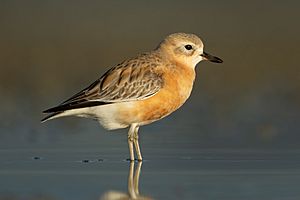New Zealand dotterel facts for kids
Quick facts for kids New Zealand dotterel |
|
|---|---|
 |
|
| Conservation status | |
| Scientific classification |
The New Zealand dotterel (Charadrius obscurus) is a species of shorebird found only in certain areas of New Zealand. It is also called the New Zealand plover or red-breasted dotterel, and its Māori names include tūturiwhatu, pukunui, and kūkuruatu.
The southern subspecies of the New Zealand plover is considered critically endangered and was nearing extinction with about 75 individuals remaining in 1990, but conservation measures increased this to 250 by 2005.
Contents
Taxonomy and systematics
The first description of the species was provided by Johann Gmelin in the 1789 edition of Systema Naturae.
A 2015 study determined that its closest relatives are two other New Zealand plovers, the wrybill, which was found to be in the Charadrius clade, and the double-banded plover.
Subspecies
Two subspecies are recognised, although a taxonomic review has supported recognition of tentative species status for each of the two populations and this was recognised in the Handbook of the Birds of the World (BirdLife, 2014) and in the conservation listing of the IUCN.
- C. o. aquilonius - Dowding, 1994: Found on the North Island (New Zealand)
- C. o. obscurus - Gmelin, JF, 1789: Found on the South Island and Stewart Island (New Zealand)
Distribution and habitat
New Zealand dotterels are usually found in two disjunct populations in New Zealand, usually on sandy beaches and sand spits or feeding in tidal estuaries. The northern population occurs on the North Island and the southern population occurs at the southern end of the South Island and on Stewart Island/Rakiura.
Breeding
Parents lay eggs in the spring and summer. They nest on beaches above the high tide mark, and the nest is just a shallow hole dug in the ground, not made of twigs like a nest in a tree. The chicks hatch about 28 days after the eggs have been laid. Because the nests are on the ground, chicks can walk the day they hatch. Chicks have to find their own food – the parents do not feed them. They can usually fly within 6–8 weeks.
Status
The IUCN, which treats the two subspecies as separate species, rates the northern subspecies as Near Threatened and the southern subspecies as Critically Endangered.
The population size of the southerly subspecies had been reduced to about 62 individual birds in 1990 and the first study of the population structure undertaken from 1988 to 1992 indicated their significant decline. Conservation measures were put in place involving the poisoning of feral cats and the population has gradually risen, with about 250 individuals being recorded in 2005. The northerly subspecies has a wider range and its population was about 1300 in 1989. It had recovered to about 1700 individuals by 2004 but only as a result of intensive management.
The northern subspecies has the conservation status of "Regionally Critical" in the Wellington Region.
Gallery
See also
 In Spanish: Chorlito maorí para niños
In Spanish: Chorlito maorí para niños






